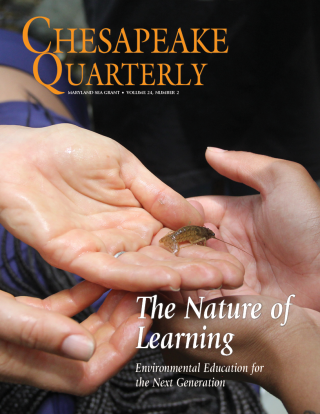Oyster Behavior in the Larval Stage
School:
Windsor Knolls Middle School / Urbana Middle SchoolLesson Plan Standards
1.1.1 1.1.2 1.1.3 1.1.5 1.2.1 1.2.2 1.2.3 1.2.6 1.2.7 1.3.4 1.4.1 1.4.2 1.4.4 1.4.6 1.4.7 1.5.1 1.5.2 1.5.5 1.5.7 1.5.9 1.7.4 3.2.1 3.5.2 3.5.3 6.4.1 6.4.3Lesson Summary
North America's largest estuary was known as "cheesepiook" in the early 17th century. The Algonquian Indian name, meaning The Great Shellfish Bay, simply noted the dominance of the Eastern oyster (Crassostrea virginica) and its importance to the health and productivity of the Bay. Today, we still call this water body the Chesapeake Bay, but nearly all the oysters are gone. Scientists are now engaged in intensive research to understand the natural history of the oyster and find ways to expand its population. A major center for this research is the University of Maryland's Horn Point Laboratory, located along the banks of the Choptank River in Cambridge, Maryland.

In the picture above Mr. Schulman works with a video camera to film oyster larvae in a water column.
Scientists hope that the results of these studies will guide an effective approach to the restoration of the Chesapeake Bay oyster population. In these lessons on Oyster Behavior in the Larval Stage, students have the opportunity to analyze actual video data from this research. The most dynamic time of an oyster's life is during its first few weeks of life. Although microscopic in size (~0.1 mm), larvae move in complex ways. Using research video data, students will employ their observational abilities to identify distinctive patterns of behavior, calculate swimming speeds, and determine whether varying ecological conditions (like temperature and salinity) affect behavior.
This unit is appropriate for grades 7 through 12. Lessons can be implemented individually or as a coherent unit.
Research Experience:
Mr. Schulman worked with Roger Newell and Victor Kennedy of the Horn Point Laboratory as part of the Chesapeake Teacher Research Fellowship. Laura Murray served as the CTRF advisor, Horn Point Laboratory, University of Maryland Center for Environmental Science, Cambridge, Maryland.Mr. Schulman is currently a science teacher at Urbana Middle School in Frederick County, MD.5E For This Lesson Plan
Engagement
Engagement
This activity captures the students' attention, stimulates their thinking, and helps them to access prior knowledge.
Historical Context: The Chesapeake Bay Oyster Population
1. To use and recognize the value of historical texts as a source of qualitative data. 2. To visualize and gain an understanding of the extraordinary productivity of the Chesapeake Bay ecosystem and its oyster population prior to the modern period. 3. To compare the current decline in the Bay's biodiversity and collapse of oyster populations to historical conditions.
Exploration
Exploration
In this section students are given time to think, plan, investigate, collect and organize information.
The Chesapeake Bay Oyster Population
1. Synthesize various informational sources to understand the current state of the Chesapeake Bay's oyster population (reading for information.)
2. Explore the causes for the collapse of the Bay's oyster population (eg., disease, sedimentation, poor water quality, and overharvesting.) EXTENSION: Higher Level Objectives
3. Explain the consequences of the decline of oyster populations (e.g., economic loss, decreased water-filtering capacity, and an overall decline in biodiversity.)
4. Identify possible solutions.
Explanation
Explanation
Students are now involved in an analysis of their own explorations. Their understanding is clarified and modified because of the reflective nature of the activities.
The Life Cycle of the Oyster
1. Understand the basic stages of development in the oyster's life cycle, from larvae to adult.
2. Identify the names of important larval stages, sizes in microns, and key features of each stage.
3. Analyze information and search for trends in data.
4. See clear diagrams, photographs, and computer images of microscopic larvae.
Extension
Extension
This section gives students an opportunity to expand and solidify their understanding of the concepts and to apply them in a real-world context.
Scientific Research: Observing the Behavior of Oyster Larvae
1. Make qualitative observations of the "swimming behavior" of oyster larvae using authentic laboratory research data.
2. Emphasize the complexity of behavior in microscopic zooplankton.
3. Improve observational skills with repeated trials and interpretive materials (i.e.,"Behavioral Checklist.")
4. Communicate observations in written and diagramatic form.
5. Identify patterns in data and summarize observations.
Oysters on the Move: Calculating Swimming Speed
1. Make quantitative observations of larval behavior using metric units (mm, cm).
2. Calculate "swimming speed" of oyster larvae using the formula for velocity [V = d/t].
3. Identify patterns in data and the influence of variables.
PowerPoint Presentation: Oyster Research at Horn Point Laboratory
1. To provide a general overview of major oyster studies.
2. To show scientific methods and apparatus -- particularly the Desk-Top Column set-up for the larval behavior studies.
Evaluation
Evaluation
This performance-based activity helps students to connect all of the pieces of information involved in these lessons.
The Great Oyster Debate
1. To integrate learning and demonstrate understanding of current ecological issues.
2. To argue an issue based on scientific principles and not belief.
3. To apply scientific knowledge to social and economic issues.



